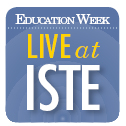At ISTE 2016, a Big Focus on Games, Projects, and Engaging Students

The annual conference hosted by the International Society for Technology in Education, which kicks off Sunday in Denver, is a gargantuan summit that draws educators and K-12 companies from across the United States, and the world.
Many of the 16,000 attendees expected to flock to ISTE 2016 come looking for ideas on how to make smart use of technology in their classrooms and schools, and for a preview of tech trends on the horizon.
For industry officials, one of the obvious draws of ISTE is the opportunity to market their products to the hilt, make connections, and win over buyers in K-12 systems. But for smart companies, the conference is also an opportunity to collect broader intel on how the tech interests of educators, administrators, and students are shifting, year-to-year.
The list of sessions on tap for ISTE 2016–there are roughly 1,000 of them–offers some clues on that front.
One of clearest themes that pervades much of ISTE this year is a focus on engaging students through technology–through games, digital portfolios, maker education, social media, and many varieties of project-based learning. It’s not a new idea by any means. But the breadth of interest and belief in capitalizing on tech’s potential to spark student curiosity is striking.
I’m not ready to say that project-based learning is ready to take on “personalized learning” as the buzz-term du jour in ed tech, but it’s a closer battle for supremacy than you might think, based on the ISTE agenda.
There are sessions on how teachers can use project-based learning to lead students into “social innovation,” and another focused on fashioning lessons that intersect with art and science.
There’s a panel on strategies for teaching project-based video game design. And let’s not overlook the sessions on project-based circuitry; project-based collaborative global lessons; project-based learning to build student “habits of mind”; and projects to cultivate student voice.
The agenda is much, much broader than that, of course. The overall session lineup is a reminder that K-12 officials everywhere are coping with sweeping questions about tech implementation across districts–and that the push to implement 1-to-1 technology is alive and well. But they’re also looking at classroom-focused questions about how teachers can use technology to improve their craft, and student learning.
For a primer on many of these challenges, and tensions, check out Education Week’s newly released special report, Technology Counts 2016: Transforming the Classroom. One highlight from the report: It offers the results of an original survey of teachers by the Education Week Research Center that probes their experiences, good and bad, using digital tools and systems.
Check back on Marketplace K-12, as well as our Digital Education blog, throughout the week for our coverage of ISTE 2016.
See also:
